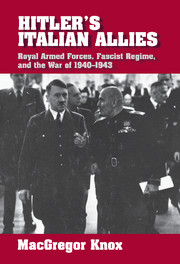Book contents
- Frontmatter
- Contents
- Acknowledgements
- List of Abbreviations
- Map
- Introduction: Defeat – and Humiliation
- 1 Fascist Italy's Last War
- 2 Society, Politics, Regime, Industry
- 3 Men and Machines: The Armed Forces and Modern Warfare
- 4 Strategy
- 5 Operations
- 6 Tactics
- Conclusion: The Weight of the Past
- Chronology
- Bibliographical Note
- Index
3 - Men and Machines: The Armed Forces and Modern Warfare
Published online by Cambridge University Press: 19 January 2010
- Frontmatter
- Contents
- Acknowledgements
- List of Abbreviations
- Map
- Introduction: Defeat – and Humiliation
- 1 Fascist Italy's Last War
- 2 Society, Politics, Regime, Industry
- 3 Men and Machines: The Armed Forces and Modern Warfare
- 4 Strategy
- 5 Operations
- 6 Tactics
- Conclusion: The Weight of the Past
- Chronology
- Bibliographical Note
- Index
Summary
From the beginning the question of whether Italy would retain a measure of dignity in defeat rested first of all with the armed forces. And of the armed forces, the army was by far the most important, for it absorbed almost two-thirds of the military budget, dominated the high command, and alone held the power to destroy the regime. “Men, our indisputable resource,” not machines, and mind over matter were the Regio Esercito's twin credos – a cultural limitation that long antedated Fascism and proved almost impervious to experience in 1940–43. Numerical superiority in infantry was in the army view the decisive factor in war, a view supposedly confirmed by the experience of 1915–18. The Regio Esercito had acquired numerous machines by that war's end, but its leaders had never accepted what the German high command had recognized as early as mid-1916: warfare had become “machine warfare.” Belief in the human will paralleled faith in numbers; both together perhaps contributed to the army's tolerance until 1939 of FIAT-Ansaldo's 3.5-ton L3 tankettes, which were easily perforated by machine-gun fire and had on occasion succumbed to Ethiopians wielding stones. Reverence for the human spirit and a culturally determined faith in genial improvisation may also have helped to cause the army's universally attested disdain for cadre and unit training.
Like its German counterpart after 1933, the army made its doctrinal and force structure decisions under the Fascist regime with considerable freedom, subject only to the dictator's demands for fighting power.
- Type
- Chapter
- Information
- Hitler's Italian AlliesRoyal Armed Forces, Fascist Regime, and the War of 1940–1943, pp. 51 - 68Publisher: Cambridge University PressPrint publication year: 2000

